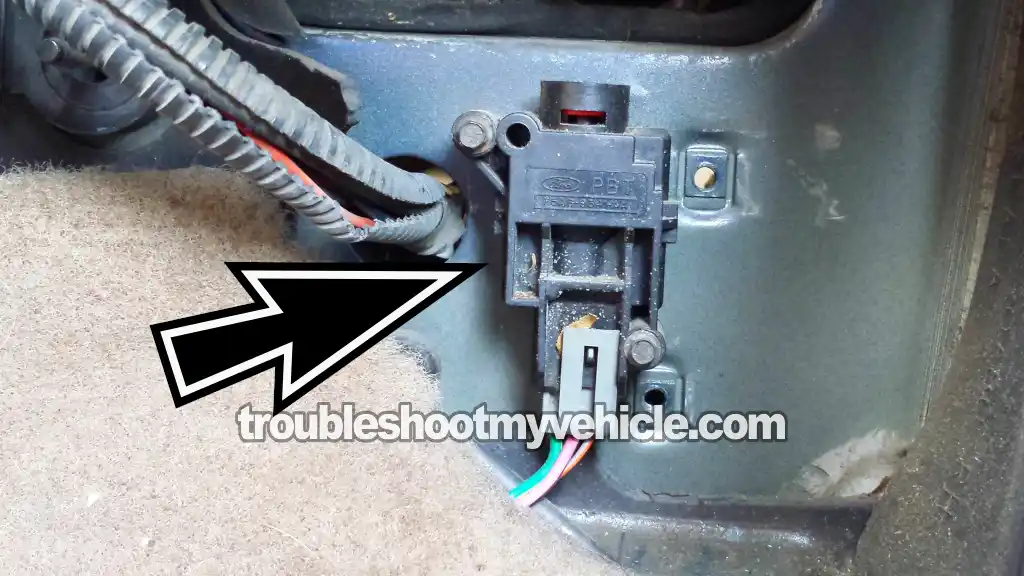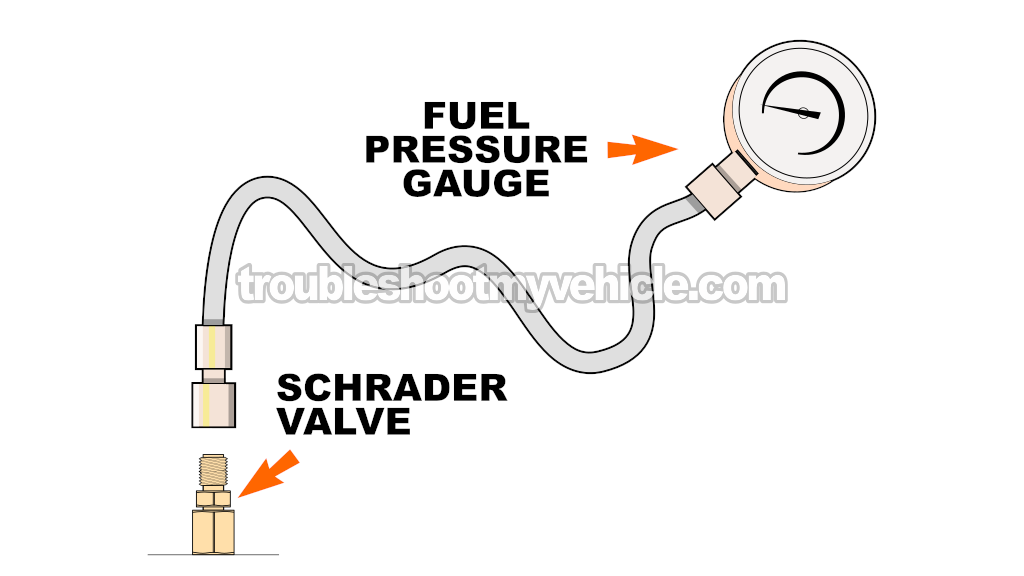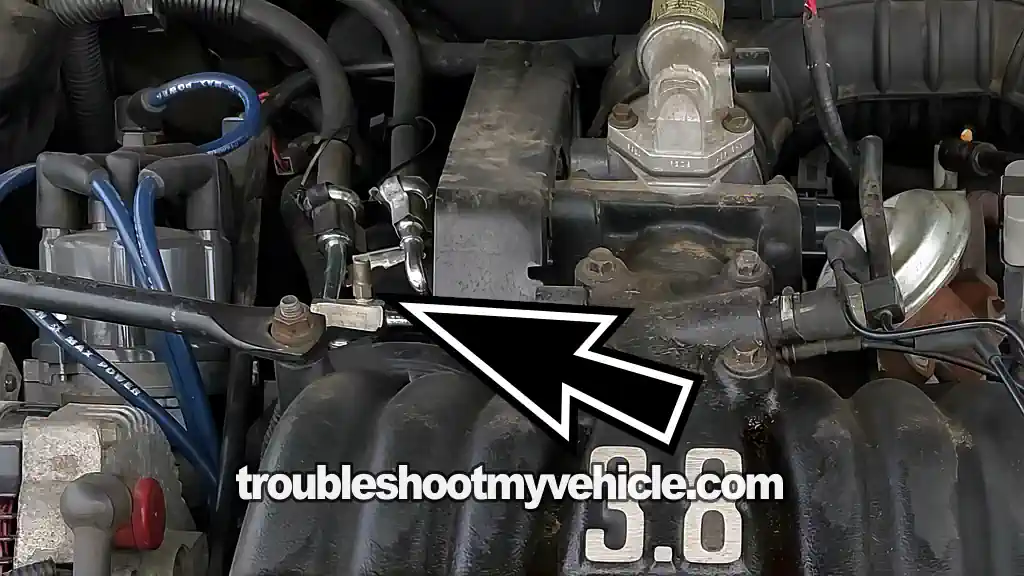
The fuel pump in the 1990–1995 3.8L V6 Ford Taurus or Mercury Sable can be easily tested using a fuel pressure test gauge.
In this tutorial, I'll explain how to perform the test and how to interpret your fuel pressure results.
With your test results, you'll quickly and easily determine whether the fuel pump is causing an engine performance issue or an engine no-start problem.
I'll also show you how to use starting fluid to check if a fuel delivery issue is preventing the engine from starting.
Contents of this tutorial:
- Symptoms Of A Bad Fuel Pump.
- Where To Buy A Fuel Pressure Test Gauge.
- Fuel Pressure Specifications.
- Fuel Pump Circuit Wiring Diagrams.
- TEST 1: Checking Fuel Pressure With A Fuel Pressure Gauge.
- TEST 2: Using Starting Fluid To Confirm Lack Of Fuel.
- Fuel Pump Inertia Switch.
- More 3.8L V6 Ford Taurus Diagnostic Tutorials.
APPLIES TO: This tutorial applies to the following vehicles:
- 3.8L V6 Ford Taurus: 1990, 1991, 1992, 1993, 1994, 1995.
- 3.8L V6 Mercury Sable: 1990, 1991, 1992, 1993, 1994, 1995.
Symptoms Of A Bad Fuel Pump
The fuel pump in your 3.8L V6 Ford Taurus (or Mercury Sable) can fail in one of two ways:
- Complete failure: In this scenario, the fuel pump completely stops working and no longer sends fuel to the injectors. The end result is that the engine will crank but won't start.
- Weak performance: In this case, the fuel pump still runs and delivers just enough fuel to get the engine started, but as soon as you put the transmission in Drive, all kinds of performance issues show up —because the fuel pump is on its way out.
When the fuel pump fails completely and no longer sends fuel to the injectors, the engine will crank but never start. On the other hand, if the pump is weak and only partially working, you'll notice one or more of the following engine performance problems:
- Lean air/fuel mixture trouble codes.
- Rough idle.
- Engine starts after extended cranking.
- Lack of power when accelerating the vehicle down the road.
- Back-fires thru' the intake manifold when accelerating your vehicle down the road.
The cool thing is, a fuel pressure test will tell you whether the no-start or performance problem is due to a bad fuel pump. That's exactly what I'm going to show you how to check —step by step— in this tutorial.
Where To Buy A Fuel Pressure Test Gauge
The main tool you'll need to check the fuel pump's pressure on your 3.8L V6 Taurus or Sable is a fuel pressure test gauge. The links below point to fuel pressure test kits that include the proper adapter to connect the gauge to your vehicle's fuel system. These kits are reliable and affordable:
Disclosure: As an Amazon Associate, I earn from qualifying purchases. If my tutorials help you, using these links is an easy way to support the site at no extra cost to you. Thank you!
Fuel Pressure Specifications
The fuel pressure on your Taurus or Sable can be measured in one of two ways: Key On Engine Off (KOEO) or Key On Engine Running (KOER). In the table below, you'll find the fuel pressure specifications for the 1990–1995 3.8L V6 Ford Taurus and Mercury Sable:
| Year | KOEO | KOER |
|---|---|---|
| 1990-1993 | 35-40 PSI | 30-45 PSI |
| 1994-1995 | 40-43 PSI | 35-38 PSI |
Fuel Pump Circuit Wiring Diagrams
- Fuel Pump Circuit Wiring Diagram (1990 3.8L V6 Ford Taurus, Mercury Sable).
- Fuel Pump Circuit Wiring Diagram (1991 3.8L V6 Ford Taurus, Mercury Sable).
- Fuel Pump Circuit Wiring Diagram (1992 3.8L V6 Ford Taurus, Mercury Sable).
- Fuel Pump Circuit Wiring Diagram (1993-1995 3.8L V6 Ford Taurus, Mercury Sable).
TEST 1: Checking Fuel Pressure With A Fuel Pressure Gauge
The thing that makes testing the fuel pump's pressure easy-peasy on your Taurus or Sable is that the fuel injector rail comes equipped with a fuel pressure test port.
This test port is commonly known as the Schrader valve, and it's located on the fuel rail right where both fuel lines connect to it.
You can check out image 2 of 2 in the image viewer above —the arrow points to the exact location of the Schrader valve.
NOTE: Before you begin the test, make sure the fuel pump inertia switch hasn't tripped. If it has, it'll cut power to the fuel pump and throw off your fuel pressure test results. For more information, take a look at this section: Fuel Pump Inertia Switch.
Here's what we need to do:
- 1
Place a shop towel around the Schrader valve. The shop towel's job is to absorb any fuel that may leak when doing step 2.
- 2
Connect the fuel pressure gauge to the Schrader valve on the fuel injector rail.
- 3
When you're ready, have your helper cycle the key ON and OFF a few times —but don't crank the engine— while you check for fuel leaks at the gauge's connection point (the Schrader valve).
If you spot any leaks, tighten the fuel pressure gauge connection slightly (by hand only) until the leaks stop. - 4
Have your helper crank the engine once you've confirmed no leaks at the gauge's connection point.
- 5
Your fuel pressure gauge should register the specified fuel pressure for the particular year of your 3.8L Ford Taurus or Sable —see: Fuel Pressure Specifications.
If the engine doesn't start, refer to the Key On Engine Off (KOEO) fuel pressure specification.
If the engine does start, refer to the Key On Engine Running (KOER) fuel pressure specification.
Let's take a look at what your results mean:
CASE 1: Fuel pressure is 0 PSI. This lack of fuel pressure confirms that the fuel pump isn't sending any fuel to the injectors —and that's what's causing the engine not to start.
The most likely cause of this zero PSI fuel pressure is a bad fuel pump. Before replacing the fuel pump, I recommend doing one more quick check: make sure the fuel pump is actually getting power.
This is a super easy test you can do at the fuel pump inertia switch. For more information on how to check for "power to the fuel pump", see this tutorial: Power To Fuel Pump Check (1991-1999 3.0L V6 Ford Taurus, Mercury Sable).
CASE 2: The fuel pressure is below specification. This test result tells you the fuel pump is failing and can't produce its maximum fuel pressure. It's time to replace the fuel pump.
CASE 3: Fuel pressure is within specification. This confirms the fuel pump is doing its job.
If you're troubleshooting an engine no-start or performance problem, this result lets you rule out the fuel pump as the culprit. You'll need to focus your troubleshooting efforts on other engine management systems that could be causing the issue.
TEST 2: Using Starting Fluid To Confirm Lack Of Fuel

From personal experience, having diagnosed countless engine no-starts, one of my go-to tests when beginning my diagnostic is the starting fluid test. This quick test will tell you right away if a lack of fuel is causing the engine not to start.
Now, before doing the starting fluid test, it's critical to make sure the engine is getting spark. On the 3.8L V6 Ford Taurus and Mercury Sable, that means checking for spark at all six spark plug wires. If there's no spark, your test result will send you chasing after ghosts —wasting both time and money.
Once you've confirmed spark, spray a small amount of starting fluid into the intake manifold and crank the engine. You'll see one of two results:
- The engine starts and runs for a few seconds: This means a lack of fuel is keeping it from starting, and the fuel pump is likely the culprit.
- The engine doesn't react at all: This tells you the issue isn't fuel-related, and you'll need to focus your troubleshooting elsewhere.
IMPORTANT: This is a very fast and easy test but you do have to take one very important safety precaution and this is to reconnect the air intake duct after spraying starting fluid down the throttle bore (although you don't have to fasten it). This will prevent any backfire, that might occur, from scaring the heck out of you when cranking the engine.
This is what you have to do:
- 1
Remove the intake air duct from the throttle body. You don't have to completely remove it, since you'll have to reconnect it in one of the next steps.
- 2
Open the throttle plate and spray starting fluid down the bore.
As a safety precaution reconnect the air duct after you have sprayed a good squirt of starting fluid (but you don't have to tighten the air duct's hose clamp). - 3
Crank the engine once the air duct is back on and you're clear of the engine compartment.
- 4
You'll get one of two results with this test:
1.) The engine will start momentarily and after a few seconds will die or.
2.) The engine will only crank but not start at all.
OK, let's find out what your results mean:
CASE 1: If the engine started and ran for a few seconds. This confirms that the engine isn't starting due to a lack of fuel. The most likely cause is a bad fuel pump.
Still, if I were in your shoes, I'd double-check by testing fuel pressure with a fuel pressure gauge. If the gauge shows zero pressure going to the fuel injectors, my next step would be to make sure power is reaching the fuel pump. Head over to: TEST 1: Checking Fuel Pressure With A Fuel Pressure Gauge.
CASE 2: The engine did not start, not even momentarily. This usually means that a lack of fuel IS NOT the reason your car is not starting.
Now, remember what I said about this test not being very accurate? Well, I suggest you do one more test and this is to check the fuel pressure with a fuel pressure test gauge. Go to: TEST 1: Checking Fuel Pressure With A Fuel Pressure Gauge.
Fuel Pump Inertia Switch

The fuel pump inertia switch is located in the trunk (for sedans) or the rear cargo area (for station wagons). In both cases, it's mounted next to the passenger-side rear wheel well. To access it, simply remove the trim panel or cover in that area.
The fuel pump inertia switch is a mechanical safety device designed to cut power to the fuel pump in the event of a car crash.
Unfortunately, it can also trip if you hit a pothole or curb hard enough. That's why it's crucial to check whether the switch has tripped before performing a fuel pressure test —if it's tripped, you'll see a zero PSI reading even if the pump itself is fine.
Resetting the fuel pump inertia switch is super easy. Just press down on the button located on top of the switch assembly. If it has been triggered, you'll feel a firm click when you push it down —this means it was tripped and has now been reset.
After resetting the switch, crank the engine. More than likely, it'll start right up.
More 3.8L V6 Ford Taurus Diagnostic Tutorials
You can find a complete list of diagnostic tutorials for the 3.8L V6 Ford Taurus and Mercury Sable in this index:
Here's a sample of the tutorials you'll find for the 3.8L Ford Taurus (Mercury Sable):
- How To Test The TPS With A Multimeter (1990-1995 3.8L V6 Taurus, Mercury Sable).
- How To Test The MAF Sensor (1991-1995 3.8L V6 Ford Taurus, Mercury Sable).
- How To Test The Engine Compression (1990-1995 3.8L V6 Ford Taurus, Mercury Sable).
- How To Test For A Blown Head Gasket (1990-1995 3.8L V6 Ford Taurus, Mercury Sable).

If this info saved the day, buy me a beer!






